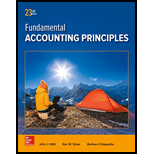
Concept explainers
Problem 3-6A
Recording prepaid expenses and unearned revenues
P1 P4
Gomez Co. had the following transactions in the last two months of its year ended December 31. (Entries can draw from the following partial chart of accounts: Cash; Prepaid Insurance; Prepaid Advertising; Prepaid Consulting Fees; Unearned Service Fees; Services Fees Earned; Insurance Expense; Advertising Expense; Consulting Fees Expense.)
Nov. 1- Paid $1,800 cash for future newspaper advertising.
1- Paid $2,460 cash for 12 months of insurance through October31 of the next year.
30- Received $3,600 cash for future services to be provided to a customer.
Dec. 1- Paid $3,000 cash for a consultant’s services to be received over the next three months.
15- Received $7,950 cash for future services to be provided to a customer.
31 Of the advertising paid for on November 1, $1,200 worth is not yet used.
31- A portion of the insurance paid for on November 1 has expired. No adjustment was made in November to Prepaid Insurance.
31- Services worth $1,500 are not yet provided to the customer who paid on November
30.
31- One-third of the consulting services paid for on December 1 have been received.
31- The company has performed $3,300 of services that the customer paid for on December 15.
Required
1. Prepare entries for these transactions under the method that initially records prepaid expenses as assets and records unearned revenues as liabilities. Also prepare
2. Prepare entries for these transactions under the method that initially records prepaid expenses as expenses and records unearned revenues as revenues. Also prepare adjusting entries at the end of the year.
Analysis Component
3. Explain why the alternative sets of entries in requirements 1 and 2 do not result in different financial statement amounts.
Want to see the full answer?
Check out a sample textbook solution
Chapter 3 Solutions
Fundamental Accounting Principles
- The partnership of Keenan and Kludlow paid the following wages during this year: Line Item Description Amount M. Keenan (partner) $108,000 S. Kludlow (partner) 96,000 N. Perry (supervisor) 54,700 T. Lee (factory worker) 35,100 R. Rolf (factory worker) 27,200 D. Broch (factory worker) 6,300 S. Ruiz (bookkeeper) 26,000 C. Rudolph (maintenance) 5,200 In addition, the partnership owed $250 to Rudolph for work he performed during December. However, payment for this work will not be made until January of the following year. The state unemployment tax rate for the company is 2.95% on the first $9,000 of each employee's earnings. Compute the following: ound your answers to the nearest cent. a. Net FUTA tax for the partnership for this year b. SUTA tax for this yeararrow_forwardGiven answer financial accounting questionarrow_forwardWhat is the true answer? ?arrow_forward
 Financial AccountingAccountingISBN:9781337272124Author:Carl Warren, James M. Reeve, Jonathan DuchacPublisher:Cengage Learning
Financial AccountingAccountingISBN:9781337272124Author:Carl Warren, James M. Reeve, Jonathan DuchacPublisher:Cengage Learning


